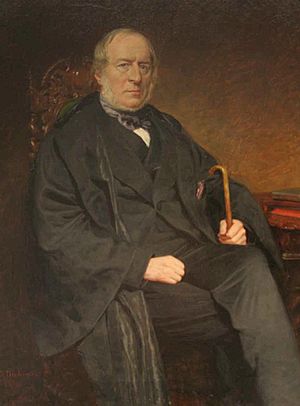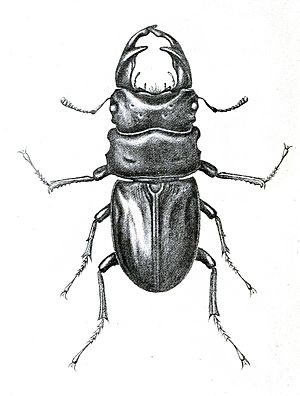Frederick William Hope facts for kids
Frederick William Hope (born January 3, 1797 – died April 15, 1862) was an English church leader and a passionate nature expert. He especially loved insects, making him an entomologist. He started a special teaching position (a professorship) at the University of Oxford. In 1849, he gave all his amazing insect collections to the university. Today, this collection is known as the Hope Collection and has about 3.5 million insect specimens! He also found and named many new kinds of insects. In 1833, he helped start the Entomological Society of London, a group for people who study insects.
About Frederick Hope
Frederick was born in London. His father was John Thomas Hope. Frederick went to Christ Church, Oxford university in 1817 and finished his studies in 1820. He briefly worked at a church in Shropshire but had to stop due to poor health.
In 1835, Hope married Ellen Meredith, who was quite wealthy. Ellen was also interested in nature and strongly supported her husband's hobbies. Frederick loved collecting things! Besides insects, he collected many other items, including:
- Over 140,000 engraved portraits (pictures of people).
- 70,000 engravings showing different places.
- 20,000 engravings of natural history (plants and animals).
Hope traveled around Europe. He studied fish and crustaceans (like crabs and lobsters). He even wrote a book about them in 1851.
His huge insect collections were offered to Oxford University in 1849. The university accepted them in 1850. A new museum was built in 1855 to house his collections. In 1860, he set up and paid for a special teaching job for zoology (the study of animals). He chose J.O. Westwood to be the first professor for this role. Westwood also took care of Hope's collections.
Hope was interested in insects from about 1817. He was especially keen on Coleoptera, which are beetles. His first insect collection was massive. It included 31 cabinets with 964 drawers, plus many books and portfolios. He kept adding to the collection, buying specimens from other famous collectors. Many of these specimens are "types," meaning they are the original examples used to describe a species.
He was a founding member of the Zoological Society of London. In 1833, he helped start the Entomological Society of London. He served as treasurer, president, and vice-president of this society at different times. Hope worked with many other naturalists of his time, including the famous Charles Darwin.
His Books and Discoveries
Frederick Hope wrote many scientific papers. About 60 of them were about entomology, mostly focusing on beetles. In these papers, he described many new types of beetles from Britain and around the world.
One of his most important books was the Coleopterists Manual. This book was published in three parts starting in 1837. It was a guide to different kinds of beetles:
- The Coleopterist's Manual: Containing The Lamellicorn Insects Of Linneus And Fabricius (1837)
- The Coleopterist's Manual: Containing The Predaceous Land And Water Beetles Of Linnaeus And Fabricius (1838)
- The Coleopterist's Manual: Containing Various Families, Genera, And Species, Of Beetles, Recorded By Linneus And Fabricius : Also Descriptions Of Newly Discovered And Unpublished Insects (1840)
He also wrote Catalogo dei crostacei Italiani e di molti altri del Mediterraneo (1851), which was about crustaceans from Italy and the Mediterranean Sea.
In 1840, Hope described how fly larvae (maggots) could sometimes infect humans. He called this condition "myasis," which is now known as myiasis in medical terms.
Images for kids







